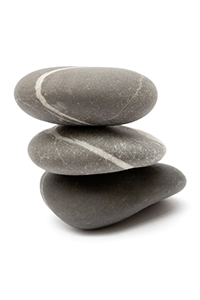Slices of Joy
Recently I finished painting our living and dining rooms. Before I repositioned the furniture I cleaned and waxed our wood floors. As I put the wax on the floor and then wiped it off I was reminded of the Karate Kid movie and that classic scene where the karate master has his student wax his car. The student is furious thinking he is not getting any lessons but rather is working for free. It is only later does he realize the benefits of the wax on, wax off arm movements in his fluid ability to block attacks and his balance skills.
While I haven't learned karate, I have learned that in waxing whether it is for the car or on the floor, it doesn't take that much to provide protection and nourishment. Just a thin layer will do. In some ways it seems counterintuitive with our more is better mentality. We think if a little will protect it, then a lot will be fantastic. The thing is, if you slab on a thick layer, it takes more work to wipe it off and it doesn't protect any better. The first layer against the wood is what gets absorbed. Piling more layers on top will just be wasted when you wipe it off.
Just a thin layer is all it takes to restore and replenish the patina on our car or floor.
I started thinking about other thin barriers or layers that impact our lives: The fragile veil of "normalcy" that separates us from sanity to insanity or the one little drink or pill that begins a tailspin of destruction.
If we think our lives are insignificant because we do not have "big, fancy, over the top" kind of lives, we need to remember that some of the thinnest things make all the difference. Kevlar is a thin layer of material but it can mean the difference of life or death. So too a condom.
We can reframe our thinking into appreciating the thin, small, seemingly insignificant things in life. According to Chade-Meng Tan in his book, Joy on Demand we can successfully change our mindset by practicing "thin slices of joy".
Usually these events are unremarkable: a bite of food, the sensation of stepping from a hot room to an air-conditioned room, the moment of connection in receiving a text from an old friend. Although they last two or three seconds, the moments add up, and the more you notice joy, the more you will experience joy, Tan argues. “Thin slices of joy occur in life everywhere… and once you start noticing it, something happens, you find it’s always there. Joy becomes something you can count on.” That’s because you’re familiarizing the mind with joy, he explains.
Turns out that our brain's basal ganglion is the area where we control habits. The more skilled we become at a particular habit, the easier it becomes to repeat it. We need to have a trigger, routine and a reward to embed this habit into our brain so that we do not have to spend much cognitive ability in doing it. In the case for slices of joy our trigger is the pleasurable moment, the routine is the observation of it and the reward is the continual building of joy.
With practicing slices of joy we are training our brains to notice small things. The more we notice, the more our lives and brains are filled with positive emotions. We are prepared for whatever the day brings because we have practiced the art of noticing slices of joy.
What about you? Have you ever noticed small slices of joy? What are some things that put a smile on your face? Things that I have noticed just this morning: the red streaks of the rising sun filtered through our neighbor's statuesque pine tree, a robin hopping along our garden edge looking for worms, the first sip of espresso, the flutter of clothing drying on the line, the dog with her face turned into the wind catching a whiff of some transient smell, the intricate details of a garden flower. If you can, try and find three slices of joy today. Each day build on that experience. Over time it can become your way of viewing the world.
And that, is significant.

